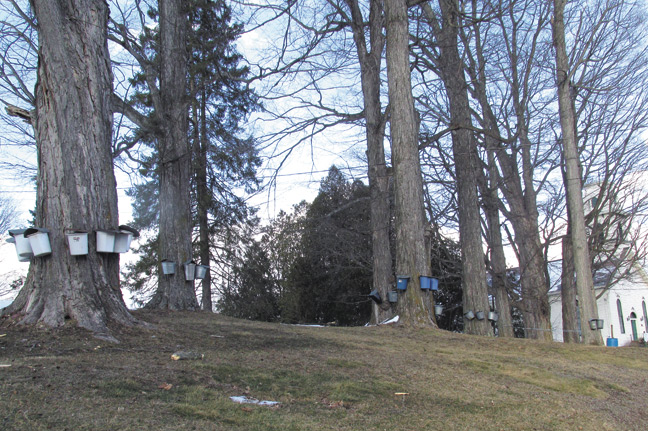UVM Proctor Page
Aesthetics of sap collecting
By TIM WILMOT, UVM EXTENSION |
Each year many new people try their hand at sugaring, and discover how satisfying it is to share syrup made with their own hard work. Most sugarmakers take great pride not only in their syrup, but in the entire process of maple production. Remember that whether you produce 2 gallons or 2000, you represent the maple industry to the public. You are making a specialty food product that is pure and natural, and your maple operation should reflect this fact. It is important to set a standard that gives the public confidence in your operation, even if it is very small.
The most observable portion of a maple operation is often the sap collecting system. One aspect that the public often notices is the tapping intensity, especially on roadside trees. For the good of the trees, efficient use of equipment, as well as for appearance sake, it’s best to use a gentle tapping guideline, especially in highly visible places. A reasonable guideline for buckets or pipeline is 1 tap for 10” trees, 2 for 18” and perhaps 3 for 24” or larger. Make sure tapholes are spread around the trunk, not clustered on the south side. While there is no law against abusing your own trees (there should be one for abusing someone else’s), when we see something like a tree with two 6” forks and a bucket on each fork, it announces “I don’t really know what I’m doing here” and doesn’t encourage the public to think that tapping is a harmless, sustainable process.
Small operations generally use some sort of bucket to collect sap, either metal or plastic, or there may be some form of tubing system leading to a roadside tank. Like many things in maple, new metal buckets are expensive and used metal buckets are widely available. Make sure that the ones you use are in good condition, not rusty, as these give a bad impression. Used galvanized buckets contain some lead but this is generally only an issue if you let sap sit in the buckets for more than a day. Don’t do that. Older “tin” buckets are hazardous—they contain too much lead. If you are using any lead containing equipment in your operation, such as galvanized metal, or 50/50 solder, you should have your syrup tested for lead every year. Due to a recent settlement in California which has extremely strict laws about foreign substances in food, even very low levels of lead in syrup considered safe throughout the rest of the US will soon have to be reduced even further.
Many plastic containers can hold sap, but only containers made from food grade plastic should be used. Food grade plastic is made with resins and dyes that have been shown not to be harmful to humans. It is possible to buy new plastic buckets made for food contact at a reasonable cost from various plastics companies, and it is often possible to find used buckets that previously held a food item for free or low cost. Make sure that you can wash them out well enough to remove any odor, and avoid buckets that once held food with a strong flavor. Some sap collection vessels do not suggest to the public that a gourmet food product, or any food product, is being made; for example: orange Home Depot buckets, sheetrock buckets, buckets that once held any non-food product such as kitty litter, laundry detergent, petroleum products, etc. Even if you wash these until the cows come home, they are still not appropriate. Likewise, plastic garbage cans, storage bins, mop buckets, barrels lined with garbage bags, etc are usually not food grade and they don’t look good.
Sap storage requires larger containers. Stainless steel is a great investment—it’s easy to clean and will last a lifetime, but it can be very expensive. Used stainless bulk tanks from dairy farms can sometimes be obtained, although not cheaply. Many smaller specialty food companies order ingredients in food-grade plastic barrels, and may sell them to you at low cost. These can be turned into very serviceable sap tanks if they are properly rinsed. Don’t wait until the season is about to begin to start cleaning them. Large square totes can work well, but be sure that the tote previously held water or a food item. Some plastic stock tanks are food grade, but stock tanks can give the impression that you are watering animals, not making a high quality food.
Roadside tubing can also have an impact on a potential customer. Spouts still in the tree in July, ancient blackened PVC tubing, lines sagging like an old clothesline—these things don’t inspire confidence in your syrup. Not all tubing is made for food or potable water contact—black pipeline should be stamped with this information, and smaller diameter tubing should be purchased from a reputable maple equipment dealer.
It is possible to make high quality syrup and violate many of the unwritten aesthetic guidelines of sugaring, but you are not doing yourself, or the maple industry as a whole any favor by leaving a visitor with the impression that sugaring is a haphazard process and results in a beautiful product only by accident. Maple syrup commands a high price not only because of its taste, but because it is perceived as a pure and natural product in a world where many sweet foods cannot make this claim. Be sure to help promote the fine image attached to maple around the globe.
Reprinted from Farming, the Journal of Northeast Agriculture September, 2010
February 2015































